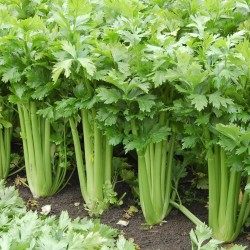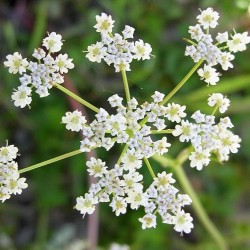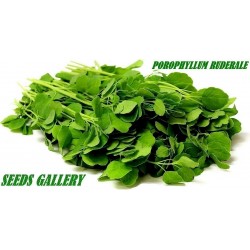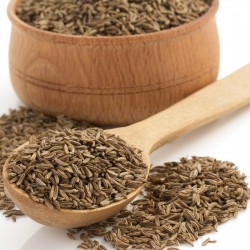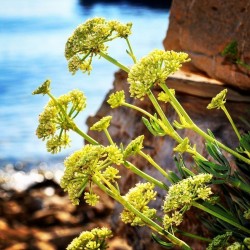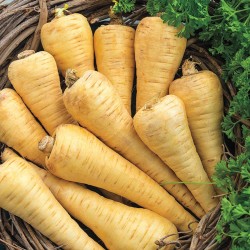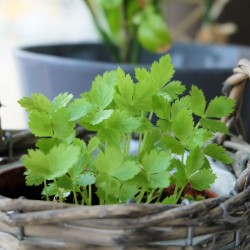
Dill seeds (Anethum...
Regular price
€1.60
-15%
Price
€1.36
(SKU: MHS 121)
Seeds Gallery EU,
5/
5
<!DOCTYPE html>
<html>
<head>
<meta http-equiv="Content-Type" content="text/html; charset=UTF-8" />
</head>
<body>
<h2><strong>Dill seeds (Anethum Graveolens)</strong></h2>
<h2><span style="color: #ff0000;"><strong>Price for Package of 900 (2g), 4500 (10g) seeds.</strong></span></h2>
<p><b>Dill</b><span> </span>(<i>Anethum graveolens</i>) is an<span> </span>annual<span> </span>herb<span> </span>in the celery family<span> </span>Apiaceae. It is the only species in the genus<span> </span><i>Anethum</i>. Dill is grown widely in<span> </span>Eurasia<span> </span>where its leaves and seeds are used as a herb or spice for flavouring food.</p>
<h2><span class="mw-headline" id="Growth">Growth</span></h2>
<p>Dill grows up to 40–60 cm (16–24 in), with slender hollow stems and alternate, finely divided, softly delicate<span> </span>leaves<span> </span>10–20 cm (4–8 in) long. The ultimate leaf divisions are 1–2 mm (0.04–0.08 in) broad, slightly broader than the similar leaves of<span> </span>fennel, which are threadlike, less than 1 mm (0.04 in) broad, but harder in texture. The<span> </span>flowers<span> </span>are white to yellow, in small<span> </span>umbels<span> </span>2–9 cm (0.8–3.5 in) diameter. The<span> </span>seeds<span> </span>are 4–5 mm (0.16–0.20 in) long and 1 mm (0.04 in) thick, and straight to slightly curved with a longitudinally ridged surface.</p>
<h2><span class="mw-headline" id="Etymology">Etymology</span></h2>
<p>The word<span> </span><i>dill</i><span> </span>and its close relatives are found in most of the Germanic languages; its ultimate origin is unknown.<sup id="cite_ref-3" class="reference">[3]</sup><span> </span>The generic name<span> </span><i>Anethum</i><span> </span>is the<span> </span>Latin<span> </span>form of<span> </span>Greek<span> </span>ἄνῑσον / ἄνησον / ἄνηθον / ἄνητον, which meant both 'dill' and 'anise'. The form<span> </span><i>anīsum</i><span> </span>came to be used for anise, and<span> </span><i>anēthum</i><span> </span>for dill. The Latin word is the origin of dill's names in the<span> </span>Western Romance languages<span> </span>(<i>anet</i>,<span> </span><i>aneldo</i>, etc.), and also of the obsolete English<span> </span><i>anet</i>.<sup id="cite_ref-4" class="reference">[4]</sup><span> </span>Most<span> </span>Slavic language<span> </span>names come from<span> </span>Proto-Slavic<span> </span><i>*koprъ</i>,<sup id="cite_ref-5" class="reference">[5]</sup><span> </span>which developed from the<span> </span>PIE<span> </span>root *<i>ku̯ə<sub>1</sub>po-</i><span> </span>'aroma, odor'.<sup id="cite_ref-6" class="reference">[6]</sup></p>
<h2><span class="mw-headline" id="History">History</span></h2>
<p>Dill has been found in the tomb of Egyptian Pharaoh<span> </span>Amenhotep II, dating to around 1400 BC.<sup id="cite_ref-pickersgill_7-0" class="reference">[7]</sup><span> </span>It was also later found in the Greek city of<span> </span>Samos, around the 7th century BC, and mentioned in the writings of<span> </span>Theophrastus<span> </span>(371–287 BC).<sup id="cite_ref-pickersgill_7-1" class="reference">[7]</sup></p>
<h2><span class="mw-headline" id="Culinary_use">Culinary use</span></h2>
<table class="infobox nowrap"><caption>Dill weed, fresh</caption>
<tbody>
<tr>
<th colspan="2">Nutritional value per 100 g (3.5 oz)</th>
</tr>
<tr>
<th scope="row">Energy</th>
<td>180 kJ (43 kcal)</td>
</tr>
<tr>
<td colspan="2"></td>
</tr>
<tr>
<th scope="row">
<div><b>Carbohydrates</b></div>
</th>
<td>
<div>7 g</div>
</td>
</tr>
<tr>
<th scope="row">Dietary fiber</th>
<td>2.1 g</td>
</tr>
<tr>
<td colspan="2"></td>
</tr>
<tr>
<th scope="row">
<div><b>Fat</b></div>
</th>
<td>
<div>1.1 g</div>
</td>
</tr>
<tr>
<td colspan="2"></td>
</tr>
<tr>
<th scope="row">
<div><b>Protein</b></div>
</th>
<td>
<div>3.5 g</div>
</td>
</tr>
<tr>
<td colspan="2"></td>
</tr>
<tr>
<th scope="row"><b>Vitamins</b></th>
<td><b>Quantity</b><span><abbr title="Percentage of Daily Value"><b>%DV</b></abbr><sup>†</sup></span></td>
</tr>
<tr>
<th scope="row">Vitamin A</th>
<td>7717 (154%) IU</td>
</tr>
<tr>
<th scope="row">Thiamine (B<span>1</span>)</th>
<td>
<div>9%</div>
0.1 mg</td>
</tr>
<tr>
<th scope="row">Riboflavin (B<span>2</span>)</th>
<td>
<div>25%</div>
0.3 mg</td>
</tr>
<tr>
<th scope="row">Niacin (B<span>3</span>)</th>
<td>
<div>11%</div>
1.6 mg</td>
</tr>
<tr>
<th scope="row">Pantothenic acid (B<span>5</span>)</th>
<td>
<div>8%</div>
0.4 mg</td>
</tr>
<tr>
<th scope="row">Vitamin B<span>6</span></th>
<td>
<div>15%</div>
0.2 mg</td>
</tr>
<tr>
<th scope="row">Folate (B<span>9</span>)</th>
<td>
<div>38%</div>
150 μg</td>
</tr>
<tr>
<th scope="row">Vitamin B<span>12</span></th>
<td>
<div>0%</div>
0 μg</td>
</tr>
<tr>
<th scope="row">Vitamin C</th>
<td>
<div>102%</div>
85 mg</td>
</tr>
<tr>
<td colspan="2"></td>
</tr>
<tr>
<th scope="row"><b>Minerals</b></th>
<td><b>Quantity</b><span><abbr title="Percentage of Daily Value"><b>%DV</b></abbr><sup>†</sup></span></td>
</tr>
<tr>
<th scope="row">Calcium</th>
<td>
<div>21%</div>
208 mg</td>
</tr>
<tr>
<th scope="row">Iron</th>
<td>
<div>51%</div>
6.6 mg</td>
</tr>
<tr>
<th scope="row">Magnesium</th>
<td>
<div>15%</div>
55 mg</td>
</tr>
<tr>
<th scope="row">Manganese</th>
<td>
<div>62%</div>
1.3 mg</td>
</tr>
<tr>
<th scope="row">Phosphorus</th>
<td>
<div>9%</div>
66 mg</td>
</tr>
<tr>
<th scope="row">Potassium</th>
<td>
<div>16%</div>
738 mg</td>
</tr>
<tr>
<th scope="row">Sodium</th>
<td>
<div>4%</div>
61 mg</td>
</tr>
<tr>
<th scope="row">Zinc</th>
<td>
<div>9%</div>
0.9 mg</td>
</tr>
<tr>
<td colspan="2"></td>
</tr>
<tr>
<th scope="row"><b>Other constituents</b></th>
<td><b>Quantity</b></td>
</tr>
<tr>
<th scope="row">Copper<span> </span>667</th>
<td>0.14 mg (7%)</td>
</tr>
<tr>
<td colspan="2">
<div class="plainlist">
<ul>
<li>Units</li>
<li>μg =<span> </span>micrograms • mg =<span> </span>milligrams</li>
<li>IU =<span> </span>International units</li>
</ul>
</div>
</td>
</tr>
<tr>
<td colspan="2" class="wrap"><sup>†</sup>Percentages are roughly approximated using<span> </span>US recommendations<span> </span>for adults.<br /><span class="nowrap">Source:<span> </span>USDA Nutrient Database</span></td>
</tr>
</tbody>
</table>
<div class="thumb tright">
<div class="thumbinner"><img alt="Dill seeds (Anethum Graveolens)" src="https://upload.wikimedia.org/wikipedia/commons/thumb/5/5b/DillEssOil.png/170px-DillEssOil.png" decoding="async" width="170" height="254" class="thumbimage" srcset="//upload.wikimedia.org/wikipedia/commons/thumb/5/5b/DillEssOil.png/255px-DillEssOil.png 1.5x, //upload.wikimedia.org/wikipedia/commons/thumb/5/5b/DillEssOil.png/340px-DillEssOil.png 2x" data-file-width="857" data-file-height="1280" title="Dill seeds (Anethum Graveolens)" />
<div class="thumbcaption">
<div class="magnify"></div>
Dill (<i>Anethum graveolens</i>) essential oil in clear glass vial</div>
</div>
</div>
<p>Fresh and dried dill leaves (sometimes called "<b>dill weed</b>" or "<b>dillweed</b>" to distinguish it from dill seed) are widely used as<span> </span>herbs<span> </span>in<span> </span>Europe<span> </span>and central Asia.</p>
<p>Like<span> </span>caraway, the fernlike leaves of dill are aromatic and are used to flavor many<span> </span>foods<span> </span>such as<span> </span>gravlax<span> </span>(cured<span> </span>salmon) and other<span> </span>fish<span> </span>dishes,<span> </span>borscht, and other<span> </span>soups, as well as<span> </span>pickles<span> </span>(where the dill flower is sometimes used). Dill is best when used fresh, as it loses its flavor rapidly if dried, however,<span> </span>freeze-dried<span> </span>dill leaves retain their flavor relatively well for a few months.</p>
<p>Dill oil<span> </span>is extracted from the leaves, stems, and seeds of the plant. The oil from the seeds is distilled and used in the manufacturing of soaps.<sup id="cite_ref-8" class="reference">[8]</sup></p>
<p>Dill is the<span> </span>eponymous<span> </span>ingredient in dill<span> </span>pickles.<sup id="cite_ref-9" class="reference"></sup></p>
<h3><span class="mw-headline" id="European_cuisine">European cuisine</span></h3>
<p>In<span> </span>central<span> </span>and<span> </span>eastern Europe,<span> </span>Scandinavia,<span> </span>Baltic states,<span> </span>Ukraine, and<span> </span>Russia, dill is a staple<span> </span>culinary herb<span> </span>along with<span> </span>chives<span> </span>and<span> </span>parsley. Fresh, finely cut dill leaves are used as a topping in soups, especially the hot red<span> </span>borsht<span> </span>and the cold borsht mixed with curds, kefir, yogurt, or sour cream, which is served during hot summer weather and is called<span> </span>okroshka. It also is popular in summer to drink fermented milk (curds, kefir, yogurt, or buttermilk) mixed with dill (and sometimes other herbs).</p>
<p>In the same way, dill is used as a topping for boiled potatoes covered with fresh butter – especially in summer when there are so-called "new", or young, potatoes. The dill leaves may be mixed with butter, making a dill butter, to serve the same purpose. Dill leaves mixed with<span> </span>tvorog, form one of the traditional cheese spreads used for sandwiches. Fresh dill leaves are used throughout the year as an ingredient in salads,<span> </span><i>e.g.</i>, one made of lettuce, fresh cucumbers, and tomatoes, as<span> </span>basil<span> </span>leaves are used in Italy and Greece.</p>
<p>Russian cuisine<span> </span>is noted for liberal use of dill, where it is known as<span> </span><i lang="ru" title="Russian language text">укроп</i>. Its supposed<span> </span>antiflatulent<span> </span>activity caused some Russian cosmonauts to recommend its use in<span> </span>human spaceflight<span> </span>due to the confined quarters and closed air supply.<sup id="cite_ref-10" class="reference">[10]</sup></p>
<p>In<span> </span>Polish cuisine, fresh dill leaves mixed with sour cream are the basis for dressings. It is especially popular to use this kind of sauce with freshly cut cucumbers, which practically are wholly immersed in the sauce, making a salad called<span> </span>mizeria. Dill sauce is used hot for baked freshwater fish and for chicken or turkey breast, or used hot or cold for hard-boiled eggs. A dill-based soup, (zupa koperkowa), served with potatoes and hard-boiled eggs, is popular in Poland. Whole stems including roots and flower buds are used traditionally to prepare Polish-style pickled cucumbers (ogórki kiszone), especially the so-called low-salt cucumbers ("ogórki małosolne"). Whole stems of dill (often including the roots) also are cooked with potatoes, especially the potatoes of autumn and winter, so they resemble the flavor of the newer potatoes found in summer. Some kinds of fish, especially trout and salmon, traditionally are baked with the stems and leaves of dill.</p>
<p>In the<span> </span>Czech Republic, white dill sauce made of cream (or milk), butter, flour, vinegar, and dill is called<span> </span><i>koprová omáčka</i><span> </span>(also<span> </span><i>koprovka</i><span> </span>or<span> </span><i>kopračka</i>) and is served either with boiled eggs and potatoes, or with dumplings and boiled beef. Another Czech dish with dill is a soup called,<span> </span><i>kulajda</i>, that contains mushrooms (traditionally wild ones).</p>
<p>In Germany, dill is popular as a seasoning for fish and many other dishes, chopped as a garnish on potatoes, and as a flavoring in pickles.</p>
<p>In the UK, dill may be used in<span> </span>fish pie.</p>
<p>In<span> </span>Bulgaria<span> </span>dill is widely used in traditional vegetable salads, and most notably the yogurt-based cold soup<span> </span>Tarator. It is also used in the preparation of sour pickles, cabbage, and other dishes.</p>
<p>In<span> </span>Romania<span> </span>dill (<i>mărar</i>) is widely used as an ingredient for soups such as<span> </span><i>borş</i><span> </span>(pronounced "borsh"), pickles, and other dishes, especially those based on peas, beans, and cabbage. It is popular for dishes based on potatoes and mushrooms and may be found in many summer salads (especially cucumber salad, cabbage salad and lettuce salad). During springtime, it is used in omelets with spring onions. It often complements sauces based on sour cream or yogurt and is mixed with salted cheese and used as a filling. Another popular dish with dill as a main ingredient is dill sauce, which is served with eggs and fried sausages.</p>
<p>In<span> </span>Hungary, dill is very widely used. It is popular as a sauce or filling, and mixed with a type of cottage cheese. Dill is also used for<span> </span>pickling<span> </span>and in salads. The Hungarian name for dill is<span> </span><i>kapor</i>.</p>
<p>In<span> </span>Serbia, dill is known as<span> </span><i>mirodjija</i><span> </span>and is used as an addition to soups, potato and cucumber salads, and French fries. It features in the Serbian proverb, "бити мирођија у свакој чорби" /biti mirodjija u svakoj čorbi/ (to be a dill in every soup), which corresponds to the English proverb "to have a finger in every pie".</p>
<p>In<span> </span>Greece, dill is known as 'άνηθος' (anithos). In antiquity it was used as an ingredient in wines that were called "anithites oinos" (wine with anithos-dill). In modern days, dill is used in salads, soups, sauces, and fish and vegetable dishes.</p>
<p>In<span> </span>Santa Maria,<span> </span>Azores, dill (<i>endro</i>) is the most important ingredient of the traditional Holy Ghost soup (<i>sopa do Espírito Santo</i>). Dill is found ubiquitously in Santa Maria, yet curiously, is rare in the other Azorean Islands.</p>
<p>In<span> </span>Sweden, dill is a common spice or herb. The top of fully grown dill is called<span> </span><i>krondill</i><span> </span>(English: Crown dill); this is used when cooking<span> </span>crayfish. The<span> </span><i>krondill</i><span> </span>is put into the water after the crayfish is boiled, but still in hot and salt water. Then the entire dish is refrigerated for at least 24 hours before being served (with toasted bread and butter).<span> </span><i>Krondill</i><span> </span>also is used for<span> </span>cucumber<span> </span>pickles. Small cucumbers, sliced or not, are put into a solution of hot water, mild acetic<span> </span>white vinegar<span> </span>(made from vodka, not wine), sugar, and<span> </span><i>krondill</i>. After a month or two of fermentation, the cucumber pickles are ready to eat, for instance, with pork, brown sauce, and potatoes, as a "sweetener". The thinner part of dill and young plants may be used with boiled fresh potatoes (especially the first potatoes of the year, "new potatoes", which usually are small and have a very thin skin). In salads it is used together with, or instead, of other green herbs, such as<span> </span>parsley,<span> </span>chives, and<span> </span>basil. It often is paired up with chives when used in food. Dill often is used to flavor fish and seafood in Sweden, for example, gravlax and various herring pickles, among them the traditional,<span> </span><b>sill i dill</b><span> </span>(literally "herring in dill"). In contrast to the various fish dishes flavored with dill, there is also a traditional Swedish dish called, dillkött, which is a meaty stew flavored with dill. The dish commonly contains pieces of veal or lamb that are boiled until tender and then served together with a vinegary dill sauce. Dill seeds may be used in breads or<span> </span>akvavit. A newer, non-traditional use of dill is to pair it with chives as a flavoring for potato chips. These are called "dillchips" and are quite popular in Sweden.</p>
<h3><span class="mw-headline" id="Asian_and_Middle_Eastern_cooking">Asian and Middle Eastern cooking</span></h3>
<table class="wikitable">
<tbody>
<tr>
<td>Nation/Region</td>
<td>Language</td>
<td>Local Name of Ingredient (Dill)</td>
<td>Dish(es) Commonly Used In</td>
</tr>
<tr>
<td>India</td>
<td>Marathi, Konkani</td>
<td>Shepu (शेपू)</td>
<td>Shepuchi Bhaji, Shepu Pulao, Ashe Mast</td>
</tr>
<tr>
<td>India</td>
<td>Hindi</td>
<td>Soa / Soya (सोआ)</td>
<td>Soa Sabzi(with potato).As a flavor in:- Green Kheema, Kheema samosa</td>
</tr>
<tr>
<td>India</td>
<td>Kannada</td>
<td>sabbasige soppu (ಸಬೈಗೆ ಸೊಪ್ಪು)</td>
<td>Curry</td>
</tr>
<tr>
<td>India</td>
<td>Telugu</td>
<td>Soa-Kura (శత పుష్పం)</td>
<td></td>
</tr>
<tr>
<td>India</td>
<td>Tamil</td>
<td>Sadakuppi (சதகுப்பி)</td>
<td>Curry</td>
</tr>
<tr>
<td>India</td>
<td>Malayalam</td>
<td>Chatakuppa (ചതകുപ്പ)</td>
<td></td>
</tr>
<tr>
<td>India</td>
<td>Punjabi</td>
<td>Soa</td>
<td></td>
</tr>
<tr>
<td>India</td>
<td>Gujarati</td>
<td>Suva</td>
<td>Suvaa ni Bhaji(with potato)</td>
</tr>
<tr>
<td>Iran</td>
<td>Persian</td>
<td>Shevid</td>
<td>Aash, Baghali Polo, Shevid Polo, Mast O Khiar</td>
</tr>
<tr>
<td>Arab world</td>
<td>Arabic</td>
<td>شبت، شبث (shabat, shabath)</td>
<td>As flavoring in various dishes</td>
</tr>
<tr>
<td>Thailand</td>
<td>Thai</td>
<td>phak chee Lao(ผักชีลาว)</td>
<td>Gaeng om(แกงอ่อม)</td>
</tr>
<tr>
<td>Vietnam</td>
<td>Vietnamese</td>
<td>Thì là</td>
<td>Many fish dishes in Northern Vietnam</td>
</tr>
<tr>
<td>China</td>
<td>Chinese</td>
<td>shiluo</td>
<td>baozi</td>
</tr>
</tbody>
</table>
<p>In<span> </span>Iran, dill is known as<span> </span><i>shevid</i><span> </span>and sometimes, is used with rice and called<span> </span><i>shevid-polo</i>. It also is used in Iranian<span> </span><i>aash</i><span> </span>recipes, and similarly, is called<span> </span><i lang="fas-Latn" title="Persian-language romanization">sheved</i><span> </span>in<span> </span>Persian.</p>
<p>In<span> </span>India, dill is known as "Sholpa" in Bengali,<span> </span><i lang="mar-Latn" title="Marathi-language romanization">shepu</i><span> </span>(शेपू) in Marathi and Konkani,<span> </span><i lang="hin-Latn" title="Hindi-language romanization">savaa</i><span> </span>in Hindi, or<span> </span><i lang="pan-Latn" title="Panjabi-language romanization">soa</i><span> </span>in Punjabi. In Telugu, it is called<span> </span><i>Soa-kura</i><span> </span>(for herb greens). It also is called<span> </span><i lang="kan-Latn" title="Kannada-language romanization">sabbasige soppu</i><span> </span>(ಸಬ್ಬಸಿಗೆ ಸೊಪ್ಪು) in<span> </span>Kannada. In<span> </span>Tamil<span> </span>it is known as<span> </span><i lang="tam-Latn" title="Tamil-language romanization">sada kuppi</i><span> </span>(சதகுப்பி). In<span> </span>Malayalam, it is ചതകുപ്പ (<i lang="mal-Latn" title="Malayalam-language romanization">chathakuppa</i>) or ശതകുപ്പ (<i lang="mal-Latn" title="Malayalam-language romanization">sathakuppa</i>). In Sanskrit, this herb is called<span> </span><i lang="san-Latn" title="Sanskrit-language romanization">shatapushpa</i>. In Gujarati, it is known as<span> </span><i lang="guj-Latn" title="Gujarati-language romanization">suva</i><span> </span>(સૂવા). In India, dill is prepared in the manner of yellow<span> </span><i>moong dal</i>, as a main-course dish. It is considered to have very good antiflatulent properties, so it is used as<span> </span><i>mukhwas</i>, or an after-meal digestive. Traditionally, it is given to mothers immediately after childbirth. In the state of Uttar Pradesh in India, a small amount of fresh dill is cooked along with cut potatoes and fresh fenugreek leaves (Hindi आलू-मेथी-सोया).</p>
<p>In<span> </span>Manipur, dill, locally known as<span> </span><i lang="mni-Latn" title="Meitei-language romanization">pakhon</i>, is an essential ingredient of<span> </span><i lang="mni-Latn" title="Meitei-language romanization">chagem pomba</i><span> </span>– a traditional Manipuri dish made with fermented soybean and rice.</p>
<p>In<span> </span>Laos<span> </span>and parts of northern<span> </span>Thailand, dill is known in English as Lao coriander (Lao:<span> </span><span lang="lo">ຜັກຊີ</span><span> </span>or<span> </span>Thai:<span> </span><span lang="th">ผักชีลาว</span>),<sup id="cite_ref-11" class="reference">[11]</sup><span> </span>and served as a side with salad yum or papaya salad. In the<span> </span>Lao language, it is called<span> </span><i>phak see</i>, and in<span> </span>Thai, it is known as<span> </span><i>phak chee Lao</i>.<sup id="cite_ref-12" class="reference">[12]</sup><sup id="cite_ref-13" class="reference">[13]</sup><span> </span>In<span> </span>Lao cuisine, Lao coriander is used extensively in traditional Lao dishes such as<span> </span><i>mok pa</i><span> </span>(steamed fish in banana leaf) and several coconut milk curries that contain fish or<span> </span>prawns.</p>
<p>In<span> </span>China<span> </span>dill is called colloquially,<span> </span><i>huíxiāng</i><span> </span>(<span lang="zh" title="Chinese language text">茴香</span>, perfums of Hui people), or more properly<span> </span><i>shíluó</i><span> </span>(<span lang="zh" title="Chinese language text">莳萝</span>). It is a common filling in<span> </span>baozi<span> </span>and<span> </span>xianbing<span> </span>and may be used as vegetarian with rice vermicelli, or combined with either meat or eggs. Vegetarian dill baozi are a common part of a Beijing breakfast. In baozi and xianbing, it often is interchangeable with non-bulbing<span> </span>fennel<span> </span>and the term<span> </span><span lang="zh" title="Chinese language text">茴香</span><span> </span>also may refer to fennel, similarly to caraway and coriander leaf, sharing a name in Chinese as well. Dill also may be<span> </span>stir fried<span> </span>as a potherb, often with egg, in the same manner as<span> </span>Chinese chives. It commonly is used in<span> </span>Taiwan<span> </span>as well. In Northern China,<span> </span>Beijing,<span> </span>Inner-Mongolia,<span> </span>Ningxia,<span> </span>Gansu, and<span> </span>Xinjiang, dill seeds commonly are called<span> </span><i>zīrán</i><span> </span>(<span lang="zh" title="Chinese language text">孜然</span>), but also<span> </span><i>kūmíng</i><span> </span>(<span lang="zh" title="Chinese language text">枯茗</span>),<span> </span><i>kūmíngzi</i><span> </span>(<span lang="zh" title="Chinese language text">枯茗子</span>),<span> </span><i>shíluózi</i><span> </span>(<span lang="zh" title="Chinese language text">莳萝子</span>),<span> </span><i>xiǎohuíxiāngzi</i><span> </span>(<span lang="zh" title="Chinese language text">小茴香子</span>) and are used with pepper for lamb meat. In the whole of China,<span> </span><i>yángchuàn</i><span> </span>(<span lang="zh" title="Chinese language text">羊串</span>) or<span> </span><i>yángròu chuàn</i><span> </span>(<span lang="zh" title="Chinese language text">羊肉串</span>), lamb<span> </span>brochette, a speciality from<span> </span>Uyghurs, uses cumin and pepper.</p>
<p>In<span> </span>Vietnam, the use of dill in cooking is regional. It is used mainly in northern Vietnamese cuisine.</p>
<h3><span class="mw-headline" id="Middle_East_uses">Middle East uses</span></h3>
<p>In Arab countries, dill seed, called<span> </span><i lang="ara-Latn" title="Arabic-language romanization">ain jaradeh</i><span> </span>(grasshopper's eye), is used as a spice in cold dishes such as<span> </span><i>fattoush</i><span> </span>and pickles. In Arab countries of the<span> </span>Persian Gulf, dill is called<span> </span><i>shibint</i><span> </span>and is used mostly in fish dishes. In<span> </span>Egypt, dillweed is commonly used to flavor<span> </span>cabbage<span> </span>dishes, including<span> </span><i>mahshi koronb</i><span> </span>(stuffed cabbage leaves).<sup id="cite_ref-14" class="reference">[14]</sup><span> </span>In Israel, dill weed is used in salads and also to flavor omelettes, often alongside parsley. It is known in Hebrew as<span> </span><i lang="heb-Latn" title="Hebrew-language romanization">shammir</i><span> </span>(שמיר).</p>
<h2><span class="mw-headline" id="Cultivation">Cultivation</span></h2>
<p>Successful cultivation requires warm to hot summers with high sunshine levels; even partial shade will reduce the yield substantially.<sup id="cite_ref-15" class="reference">[15]</sup><span> </span>It also prefers rich, well-drained soil. The seeds are viable for three to ten years.<sup id="cite_ref-16" class="reference">[16]</sup><span> </span>The plants are somewhat<span> </span>monocarpic<span> </span>and quickly die after "bolting" (producing seeds). Hot temperatures may quicken bolting.<sup id="cite_ref-17" class="reference"></sup></p>
<p>The seed is harvested by cutting the flower heads off the stalks when the seed is beginning to ripen. The seed heads are placed upside down in a paper bag and left in a warm, dry place for a week. The seeds then separate from the stems easily for storage in an airtight container.</p>
<p>These plants, like their fennel and parsley relatives, often are eaten by<span> </span>Black swallowtail caterpillars<span> </span>in areas where that species occurs.<sup id="cite_ref-18" class="reference">[18]</sup><span> </span>For this reason, they may be included in some<span> </span>butterfly gardens.</p>
<h2><span class="mw-headline" id="Companion_planting">Companion planting</span></h2>
<div class="thumb tright">
<div class="thumbinner"><img alt="Dill seeds (Anethum Graveolens)" src="https://upload.wikimedia.org/wikipedia/commons/thumb/d/de/Anethum_graveolens_001.JPG/220px-Anethum_graveolens_001.JPG" decoding="async" width="220" height="165" class="thumbimage" srcset="//upload.wikimedia.org/wikipedia/commons/thumb/d/de/Anethum_graveolens_001.JPG/330px-Anethum_graveolens_001.JPG 1.5x, //upload.wikimedia.org/wikipedia/commons/thumb/d/de/Anethum_graveolens_001.JPG/440px-Anethum_graveolens_001.JPG 2x" data-file-width="1772" data-file-height="1329" title="Dill seeds (Anethum Graveolens)" />
<div class="thumbcaption">
<div class="magnify"></div>
Dill plants</div>
</div>
</div>
<p>When used as a<span> </span>companion plant, dill attracts many beneficial insects as the umbrella flower heads go to seed. It makes a good companion plant for cucumbers and broccoli.</p>
<p>It is a poor companion plant for carrots and tomatoes.</p>
<table cellspacing="0" cellpadding="0" border="1">
<tbody>
<tr>
<td colspan="2" width="100%" valign="top">
<p><span style="color: #008000;"><strong>Sowing Instructions</strong></span></p>
</td>
</tr>
<tr>
<td valign="top" nowrap="nowrap">
<p><span style="color: #008000;"><strong>Propagation:</strong></span></p>
</td>
<td valign="top">
<p><span style="color: #008000;">Seeds</span></p>
</td>
</tr>
<tr>
<td valign="top" nowrap="nowrap">
<p><span style="color: #008000;"><strong>Pretreat:</strong></span></p>
</td>
<td valign="top">
<p><span style="color: #008000;">0</span></p>
</td>
</tr>
<tr>
<td valign="top" nowrap="nowrap">
<p><span style="color: #008000;"><strong>Stratification:</strong></span></p>
</td>
<td valign="top">
<p><span style="color: #008000;">0</span></p>
</td>
</tr>
<tr>
<td valign="top" nowrap="nowrap">
<p><span style="color: #008000;"><strong>Sowing Time:</strong></span></p>
</td>
<td valign="top">
<p><span style="color: #008000;">all year round</span></p>
</td>
</tr>
<tr>
<td valign="top" nowrap="nowrap">
<p><span style="color: #008000;"><strong>Sowing Depth:</strong></span></p>
</td>
<td valign="top">
<p><span style="color: #008000;">Cover lightly with substrate</span></p>
</td>
</tr>
<tr>
<td valign="top" nowrap="nowrap">
<p><span style="color: #008000;"><strong>Sowing Mix:</strong></span></p>
</td>
<td valign="top">
<p><span style="color: #008000;">Coir or sowing mix + sand or perlite</span></p>
</td>
</tr>
<tr>
<td valign="top" nowrap="nowrap">
<p><span style="color: #008000;"><strong>Germination temperature:</strong></span></p>
</td>
<td valign="top">
<p><span style="color: #008000;">min. 15 ° C</span></p>
</td>
</tr>
<tr>
<td valign="top" nowrap="nowrap">
<p><span style="color: #008000;"><strong>Location:</strong></span></p>
</td>
<td valign="top">
<p><span style="color: #008000;">bright + keep constantly moist not wet</span></p>
</td>
</tr>
<tr>
<td valign="top" nowrap="nowrap">
<p><span style="color: #008000;"><strong>Germination Time:</strong></span></p>
</td>
<td valign="top">
<p><span style="color: #008000;">2-3 weeks</span></p>
</td>
</tr>
<tr>
<td valign="top" nowrap="nowrap">
<p><span style="color: #008000;"><strong>Watering:</strong></span></p>
</td>
<td valign="top">
<p><span style="color: #008000;">Water regularly during the growing season</span></p>
</td>
</tr>
<tr>
<td valign="top" nowrap="nowrap">
<p><span style="color: #008000;"><strong> </strong></span></p>
</td>
<td valign="top">
<p><br /><span style="color: #008000;"><em>Copyright © 2012 Seeds Gallery - Saatgut Galerie - Galerija semena. </em><em>All Rights Reserved.</em><em></em></span></p>
<div><span style="color: #008000;"><em> </em></span></div>
</td>
</tr>
</tbody>
</table>
</body>
</html>
MHS 121 (2g)

- -15%
- New





